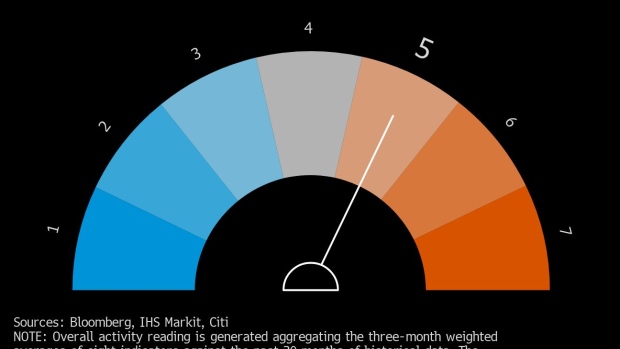Oct 26, 2021
Festive Season Fuels India’s Return to World-Beating Growth
, Bloomberg News

(Bloomberg) -- India showed more signs of a recovery taking hold last month as its consumption-driving festive season kicked off, keeping it on track to regain the title of the world’s fastest-growing major economy.
An array of indicators compiled by Bloomberg News pointed to a continuing rebound in demand in September, helping keep the needle on a dial measuring so-called animal spirits steady at 5 for a third straight month. Sentiment in the dominant services and manufacturing sectors was strong, thanks to a surge in new orders. Bank loan disbursals also grew as Asia’s third-largest economy slowly emerged from the shadows of the Covid-19 pandemic.
The recovery coincides with the start of India’s months-long festive season beginning with Ganesh Chaturthi in September, heralding the boom season for consumption. The International Monetary Fund, as well as India’s central bank, this month estimated the nation’s gross domestic product will grow 9.5% in the year ending March -- the quickest pace among major economies -- after contracting 7.3% last year.
Below are the details of the dashboard, which tracks eight indicators and ranks them based on three-month weighted average scores. (For an alternative gauge of growth trends, follow Bloomberg Economics’ monthly GDP tracker -- a weighted index of 11 activity indicators.)
Business Activity
Surveys of purchasing managers at Indian factories and services companies by IHS Markit pointed to a steady expansion in activity last month, boosted by stronger new order inflows. That kept the composite index in growth territory for a second straight month. The advance was accompanied by an acceleration in input cost inflation, due mainly to a shortage of raw materials and higher commodity prices.
Exports
Exports rose about 23% year-on-year in September, while also improving 1.6% from a month earlier, led by demand for petroleum products, engineering goods, Indian coffee and gems and jewelry. Imports too jumped, mainly due to a 254% year-on-year surge in gold purchases.
Consumer Activity
Retail auto sales, a bellwether of consumer demand, bucked the expansionary trend. Sales of passenger vehicles, which include cars and SUVs, fell 41% from a year ago as carmakers cut production due to a global chip shortage. Two-wheeler sales -- an indicator of animal spirits in smaller towns -- also declined.
Bank credit grew 6.7% in September from a year earlier, maintaining the pace of expansion seen in August, central bank data showed. Liquidity conditions remained surplus last month, implying room for more credit off-take.
Industrial Activity
Industrial production expanded 11.9% in August from a year earlier, although the index was little changed from a month ago. While the easing of pandemic curbs likely aided the year-on-year pick-up, Bloomberg Economics sees risks to the momentum from coal shortages and a power crunch.
Similarly, output at infrastructure industries, which makes up 40% of the industrial production index, expanded 11.6% in August, with demand for coal, natural gas and cement continuing to drive activity. Both data are published with a one-month lag.
©2021 Bloomberg L.P.


